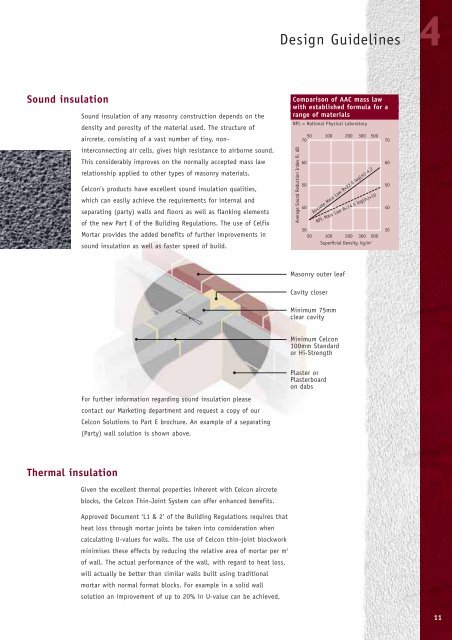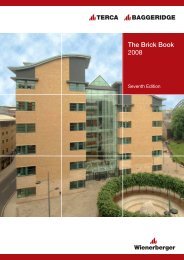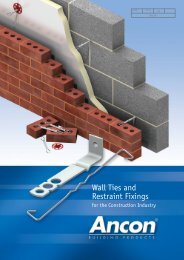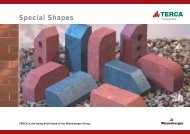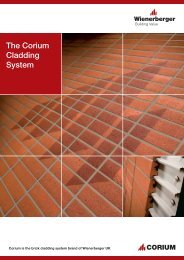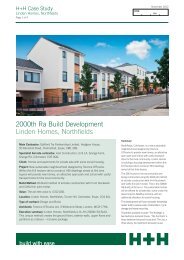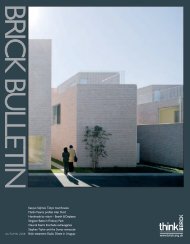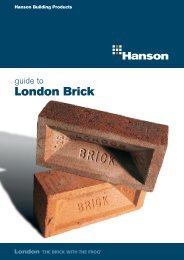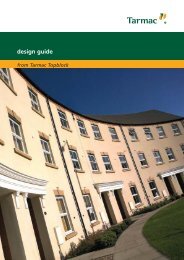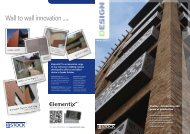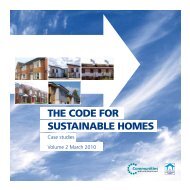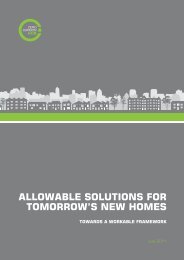The Celcon Thin-Joint System A Definitive Guide - Masonry First
The Celcon Thin-Joint System A Definitive Guide - Masonry First
The Celcon Thin-Joint System A Definitive Guide - Masonry First
You also want an ePaper? Increase the reach of your titles
YUMPU automatically turns print PDFs into web optimized ePapers that Google loves.
Sound insulation<br />
<strong>The</strong>rmal insulation<br />
Sound insulation of any masonry construction depends on the<br />
density and porosity of the material used. <strong>The</strong> structure of<br />
aircrete, consisting of a vast number of tiny, noninterconnecting<br />
air cells, gives high resistance to airborne sound.<br />
This considerably improves on the normally accepted mass law<br />
relationship applied to other types of masonry materials.<br />
<strong>Celcon</strong>’s products have excellent sound insulation qualities,<br />
which can easily achieve the requirements for internal and<br />
separating (party) walls and floors as well as flanking elements<br />
of the new Part E of the Building Regulations. <strong>The</strong> use of Celfix<br />
Mortar provides the added benefits of further improvements in<br />
sound insulation as well as faster speed of build.<br />
For further information regarding sound insulation please<br />
contact our Marketing department and request a copy of our<br />
<strong>Celcon</strong> Solutions to Part E brochure. An example of a separating<br />
(Party) wall solution is shown above.<br />
Given the excellent thermal properties inherent with <strong>Celcon</strong> aircrete<br />
blocks, the <strong>Celcon</strong> <strong>Thin</strong>-<strong>Joint</strong> <strong>System</strong> can offer enhanced benefits.<br />
Approved Document ‘L1 & 2’ of the Building Regulations requires that<br />
heat loss through mortar joints be taken into consideration when<br />
calculating U-values for walls. <strong>The</strong> use of <strong>Celcon</strong> thin-joint blockwork<br />
minimises these effects by reducing the relative area of mortar per m2 of wall. <strong>The</strong> actual performance of the wall, with regard to heat loss,<br />
will actually be better than similar walls built using traditional<br />
mortar with normal format blocks. For example in a solid wall<br />
solution an improvement of up to 20% in U-value can be achieved.<br />
Design <strong>Guide</strong>lines<br />
Comparison of AAC mass law<br />
with established formula for a<br />
range of materials<br />
NPL = National Physical Laboratory<br />
Average Sound Reduction Index R, dB<br />
50 100 200 300 500<br />
70<br />
60<br />
50<br />
40<br />
30<br />
50 100 200 300 500<br />
Superficial Density, kg/m 2<br />
<strong>Masonry</strong> outer leaf<br />
Cavity closer<br />
Minimum 75mm<br />
clear cavity<br />
Minimum <strong>Celcon</strong><br />
100mm Standard<br />
or Hi-Strength<br />
Plaster or<br />
Plasterboard<br />
on dabs<br />
Aircrete Mass Law R=22.9 log(m)-4.2<br />
NPL Mass Law R=14.5 log(m)+10<br />
70<br />
60<br />
50<br />
40<br />
30<br />
4<br />
11


